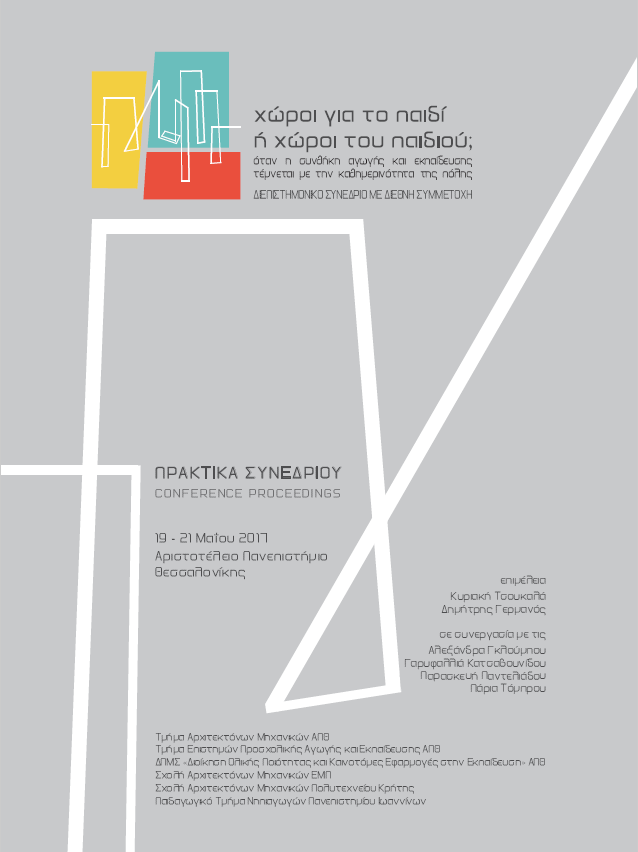Δημιουργώντας τον χώρο του παιδιού στο σχολείο: η προσέγγιση από την πλευρά του χρήστη και ο παιδαγωγικός σχεδιασμός του χώρου

Περίληψη
Ο σχεδιασμός του σχολικού κτιρίου υπόκειται σε κανονισμούς που αποσκοπούν στη δημιουργία χώρου μέσω δύο στόχων: την υλοποίηση των παιδαγωγικών και κοινωνικών κατευθύνσεων της εκπαίδευσης και την προσαρμογή του εκπαιδευτικού περιβάλλοντος στον μαθητή.
Όπως δείχνει η έρευνα στην Ελλάδα, ο σχολικός χώρος χαρακτηρίζεται από ξεπερασμένα αρχιτεκτονικά και παιδαγωγικά στερεότυπα που εμποδίζουν την εκπαιδευτική αναβάθμιση του σχολείου. Τα στερεότυπα αυτά διαμορφώνουν ένα εκπαιδευτικό περιβάλλον για το παιδί με κριτήριο το τι πρέπει να κάνει αντί για το τι είναι το παιδί.
Σε αντίθετο προσανατολισμό, η προσέγγιση του σχεδιασμού του σχολικού χώρου που προσαρμόζεται στον ίδιο τον μαθητή τον θεωρεί ενεργό συμμετέχοντα στην εκπαιδευτική διαδικασία. Αυτή είναι η προσέγγιση από την πλευρά του Χρήστη (η προσέγγιση "U") που συναρτά τις γνωστικές και ψυχοκοινωνικές απαιτήσεις της εκπαιδευτικής διαδικασίας με τα ηλικιακά χαρακτηριστικά και τα κέντρα ενδιαφέροντος του μαθητή, τα οποία και ενσωματώνει στον αρχιτεκτονικό σχεδιασμό.
Η προσέγγιση αυτή υλοποιείται μέσω της μεθόδου του Παιδαγωγικού Σχεδιασμού του Χώρου, που χρησιμοποιεί τα κριτήρια της διευθέτησης και χρήσης του σχολικού χώρου τα οποία συσχετίζουν τα χαρακτηριστικά του παιδιού με εκείνα της συνεργατικής μεθόδου. Η εφαρμογή αυτής της μεθόδου στα σχολεία της Ελλάδας και της Κύπρου δίνει μια εναλλακτική λύση για τη δημιουργία παιδικών χώρων στο εκπαιδευτικό περιβάλλον.
Λεπτομέρειες άρθρου
- Ενότητα
- ΕΙΣΗΓΗΣΕΙΣ ΚΕΝΤΡΙΚΩΝ ΟΜΙΛΗΤΩΝ
Οι συγγραφείς των άρθρων που δημοσιεύονται διατηρούν τα δικαιώματα πνευματικής ιδιοκτησίας επί των άρθρων τους, δίνοντας το δικαίωμα της πρώτης δημοσίευσης.
Άρθρα που δημοσιεύονται διατίθενται με άδεια Creative Commons 4.0 και σύμφωνα με την άδεια μπορούν να χρησιμοποιούνται ελεύθερα, με αναφορά στο/στη συγγραφέα και στην πρώτη δημοσίευση για μη κερδοσκοπικούς σκοπούς.
Οι συγγραφείς μπορούν να καταθέσουν το άρθρο σε ιδρυματικό ή άλλο αποθετήριο ή/και να το δημοσιεύσουν σε άλλη έκδοση, με υποχρεωτική την αναφορά πρώτης δημοσίευσης στα πρακτικά.
Οι συγγραφείς ενθαρρύνονται να καταθέσουν σε αποθετήριο ή να δημοσιεύσουν την εργασία τους στο διαδίκτυο πριν ή κατά τη διαδικασία υποβολής και αξιολόγησής της.


